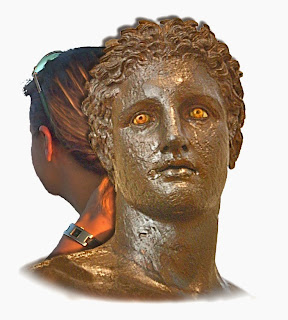Dear Reader,
Today has been wonderful for this
writer on the loose!
 |
| Inside the Guardian! |
I spent the morning and afternoon at seminars about blogging (twitter #bloglikeapro) in the Guardian building near Kings Cross. I learned a whole raft of ways in which your experience of my blog can be made more pleasant and useful.
You will see some (gradual) changes as the months go by and I learn how to put them
into practice. I also talked to other interested writers about The Boy with Two Heads and Trifolium Books. And I handed out some flyers. This always feels good!
Once the seminars finished, I set off into London via Kings Cross Station - my first visit since it was renovated. How could I resist taking photos?

 And I found Platform Nine and Three-Quarters ... It has a shop, too.
And I found Platform Nine and Three-Quarters ... It has a shop, too.  Later, over a Greek meal near Regents
Park, I read part of Louis de Bernieres' ImaginingAlexandria. ‘To the Scandal of Poets’ made me laugh out loud (which
disconcerted the Greek waiter – older woman on her own enjoying herself?) and ‘The
Man who Travelled the World’ made me want to cry. De Bernieres says his poems are a tribute to the Alexandrian Greek poet, C P Cavafy, but they have other dimensions, too.
Later, over a Greek meal near Regents
Park, I read part of Louis de Bernieres' ImaginingAlexandria. ‘To the Scandal of Poets’ made me laugh out loud (which
disconcerted the Greek waiter – older woman on her own enjoying herself?) and ‘The
Man who Travelled the World’ made me want to cry. De Bernieres says his poems are a tribute to the Alexandrian Greek poet, C P Cavafy, but they have other dimensions, too.
On the way home I once again enjoyed the view of the London Eye from Charing Cross.
So for me this day had all the elements
of the perfect writer's day – lots of research, other writers for company,
beautiful things to see and be inspired by, good food for stomach and mind, and
a glass of good wine.
Just one thing: I didn't write anything!
But I have re-organised the blog a bit. Please let me know what you think – addresses below.
 |
| Oxford Street at sunset, Dec 31st 2013 |
P. S.
Sorry if my title led you to expect
tales of debauchery and forbidden pleasures (and/or shopping?). You might find more excitement
(though I doubt debauchery) on the Time Out in London blog run by our midday
speaker today, Sonya Barber. The whole city is there!
You can contact me via:
Comment on this blog
@JuliaMNewsome on Twitter
'J M Newsome, author' on Facebook
All photos my own (sorry about the Platform Nine and Three-Quarters quality) except the cover of Imagining Alexandria, which is from Amazon's relevant page.








